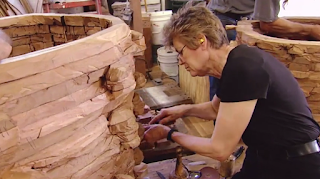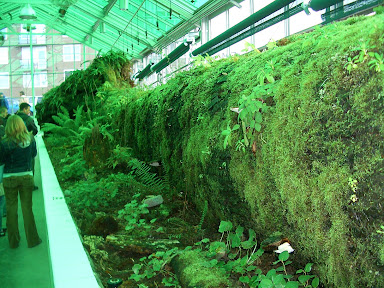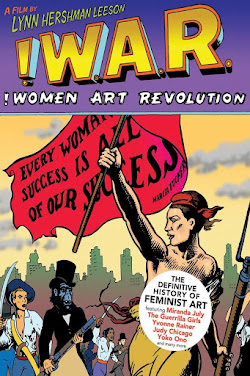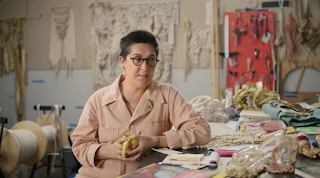Art21: "Ecology" (S4, E3)
In this episode of Art21, artists focus upon the theme of "ecology." The artists featured are Ursula von Rydingsvard, Iñigo Manglano-Ovalle, Robert Adams, and Mark Dion.
Ursula working on project. 2007. "Ecology," Art21
Ursula von Rydingsvard is a New York based sculptor that specializes in making wooden sculptures. She grew up with 7 sibling after WW2 in a refugee camp for Polish people in Germany. Through her struggles, she believed that "working hard was the answer to life." Her works seem to be very abstract in look but each conveys the harmony between the man-made with nature. She builds everything out of Cedar, and builds her sculptures, layer by layer. She draws on the outside of each of the pieces, those pieces are cut, and her team mark them on the outside and inside so that if any of the pieces were to get lost or tossed away, they can easily find them and put them together where they belong. Once the pieces are cut, they build the sculpture in its entirety and screw the layers together, until they are ready to glue it layer by layer. When the entire piece is ready and glued together, she paints over the cedar to add shadows and highlights with either a brush or spray can. She never plans out the works prior to making them, as she believes they "limit her options," and rather lets her work end up a "surprise" or an exploration of her emotions. I found that the works they showcased in the episode to be visually interesting. I was amazed at the intricate details she is able to convey, as wood is very difficult to cut (which I know from experience). There were lots of the sharp edges but also some soft, gradient curves. What stands out to me the most was the overall natural-ness of it, that despite them being glued and screwed together (conveying the sense of the industrial, "man-made" idea), they feel that they have a natural presence to them to which they do exist in everyday life. In other words, the sculptures seem other-worldly, that it almost doesn't exist in its environment, despite it "taking space" and looking like something that could exist in our environment. Maybe it conveys a sense of natural disconnected-ness, that despite our efforts in trying to preserve and beautify our environment, Nature is "untouchable" and "unable" to be replicated? I implore you to check out more of her works (her website is https://ursulavonrydingsvard.net/, and she even has an Instagram @ursulavonryd), as these works are truly something to see to believe.

Exploding Bowl (2005-06) Cedar. 32 × 56 × 55 inches. Galerie Lelong, New York.

Iñigo Manglano-Ovalle being interviewed about Cloud Prototype #1. 2007. "Ecology," Art21
Iñigo Manglano-Ovalle is an American conceptual artist that dives into a range of materials, especially film and sculpture. All his work has an "underlying politics to it," but he hesitates to reveal himself (rather he just hints at it). He utilizes his works to further dive into his understanding of social issues, especially when it comes to Nature. He even mentions that he wants to dive into the "troublesome condition." He said that he was interested in Weather Patterns within and outside architecture. For instance, in Random Sky, the weather station (outside) takes in readings for the temperature, barometric pressure, wind speed and wind direction and sends the data to a set of computers that use it to create blue and white scan lines. As such, this piece is meant to combine technology with nature, whilst allowing individuals to be directly involved as they are able to walk around and interact with the piece. Cloud Prototype #1 was a thunderstorm captured three-dimensionally by the department of atmospheric sciences at Illinois University. This work was meant to "stop" time, but in this case, it was to be right before the storm erupts. He mentions something also profound that I found myself sitting with: "catching ephemera is an impossibility. And in the end, you really haven't captured ephemera, you've made a sculpture." This really stuck with me, especially how his works do have a sense of the impossibility of capturing time or stability. You could say that he was truly capturing time by how he connected his Random Sky with actual weather reports, but the data changes every second. Cloud Prototype #1 may have been intended to capture how the cloud looked, but keep in mind this was just before the big storm. He even mentions that a thunderstorm is "one of the most destructive and most productive elements," diving into the idea that even with things changing, there is a sense of beauty and hope that comes with it. To which, isn't it amazing that things do change, and that we should take heed in what is happening now as we will never have a means to keep it forever.

Random Sky (2006). 7680 x 1024 Resolution. Continuous real-time digital output; single channel, 10-projection screens; weather transmitter with temperature, barometric, wind speed and direction instrumentation; and 7.1 surround sound. Collaboration with Mark Hereld and Rick Gribenas. Hyde Park Art Center, Chicago.

Robert Adams discussing his "The New West" works. 2007. "Ecology," Art21
Robert Adams is an American photographer and his subject is the American West. He began his photography in Colorado, and photographed the suburban strip, the tract houses and highways. When he took them to the dark room to process them, he felt surprise that he admired the pictures, because he believed he would hate them. "They were unexpectedly, disconcertingly glorious." Thus, he created a whole series called "The New West." He likes to document what makes the West "glorious," wanting to be both "truthful" and what is "disturbing" about it (to find the balance to where "everything fits" as he puts it). His work also seems to like to emphasize how light plays a role. For instance, his Colorado Springs, Colorado depicts a silhouetted woman inside of her home on a bright sunny day. I thought Robert would discuss how separated the woman is from the outside, focusing on the isolation and loneliness of being away from Nature. However, he discussed how her seclusion is surrounded by a great "sublime "light from the sky, saying "there's no light like Colorado." In this sense, the dramatic use of light and dark heightens the emotional intensity of the piece, helping to convey the separation between the industrial world with the natural world, the sadness with thriving life. He also talked about how hard it is to capture a landscape, especially a sea-scape, as both are constantly changing. He notes that "it was just surrendering yourself to something," like as though he connects with Nature by how he allows it to take hold of itself. In other words, he doesn't try to "freeze" what he is seeing, but rather acknowledges the changes that take place in life and allows the change to be emphasized to the viewer. In relation to this, his Looking Past Citrus Groves into the San Bernardino Valley; Northeast of Riverside, California conveys that despite there being a smog over the landscape, there is still a presence of light that somehow penetrates it. With this sense, despite areas being penetrated with industrialization and pollution, there is still that "hint" that Nature is still foreboding. Through this, Nature still exists and will continue to exist, despite all of what we may have done to destroy it. Although a gloomy tone, maybe its to say that there is still hope to reinvigorate Nature and make it better, even when we have done many things that has destroyed it over the years. To which, this hope is something that is central and evident in his works that the viewer can relate to.
Looking Past Citrus Groves into the San Bernardino Valley; Northeast of Riverside, California (1983) Gelatin silver print. 16 × 20 inches. Fraenkel Gallery, San Francisco and Matthew Marks Gallery, New York

Mark Dion and his team planning the Neukom Vivarium project. 2007. "Ecology," Art21
Like Iñigo Manglano-Ovalle, Mark Dion is an American conceptual artist that uses his work to understand the world around us, in terms of history and the natural world. From what Art21 showcased, he admits to love collecting stuff and buying things, and his home looks extremely cluttered. However, he also acknowledges that some of those things are utilized in his sculptures, since he feels that "you really get an idea of what people thought about the natural world at a particular time" through the items that he has collected over the years. His goals is to to not precisely look forward towards the future, but rather "hold a mirror" towards the present. He is interested in the ideas about Nature, and examining them deeper to determine their historical groundwork. For instance, his Neukom Vivarium examines Nature in relation with time. He and his team went to a nearby forest to take a dead tree that fell over to the city. In his words, "the tree is the basis of the next forest. The tree supports a living biosystem in it," to which "the tree is giving life through it's death." In other words, despite the fact that the tree has fallen, it still has the pieces left inside to sustain the rest of the natural world. And one day, a new tree will rise again and go through the same process. To him, "that's part of the excitement of this piece," as "once it's finished it's just starting." Interestingly, the location for this installation used to be a hazardous waste site, so Mark would be essentially bringing life back into it (as a waste site would be a place where decay, rot and death are all evident). He also acknowledges that the tree existed there before the community came, thus he is also bringing Nature back to the city. The building that surround the tree is made of green glass, to which the individual enters through the narrowest space, allowing the environment to surrounded the individual. There is a water system and cooler system inside, along with solar panels to allow for clean energy, as he means to "replicate what Nature can do." He also enlisted wildlife illustrators to create drawings on titles outside of what organisms lived on the tree, which serves to further educate the public on the tree's ecosystem. All in all, he wanted to emphasize "Nature as a process," hoping the public "leaves with more questions than when they came in."
I believe this had to be one of my favorite Art21 episodes that I have seen. All the art showcased grabbed my attention and they all had prominent important themes behind them. What I noticed is that all of the artists seem to want to capture the connection between Nature and our industrial city, either by trying to combine these two polar opposites together or trying to find a way to bring importance back into Nature. By definition, ecology means to understand organisms and their environments. Thus, these artists mean to understand the aspects of Nature to further emphasize the importance to protect and continue sustaining it. In Mark Dion's words:
"We're at this kind of moment in time where we have a great test ahead of us in terms of our relationship to the natural world. If we pass the test, we get to keep the planet. But I don't really see us doing a very good job of that right now."
To learn more on how to help our environment, go to https://oceanservice.noaa.gov/ocean/earthday.html or https://indianapublicmedia.org/amomentofscience/20-easy-ways.php.
Information Sources:
https://art21.org/artist/ursula-von-rydingsvard/
https://art21.org/artist/inigo-manglano-ovalle/
https://art21.org/artist/robert-adams/
https://www.merriam-webster.com/dictionary/ecology
* This episode was 53 minutes and 35 seconds long.*





Comments
Post a Comment